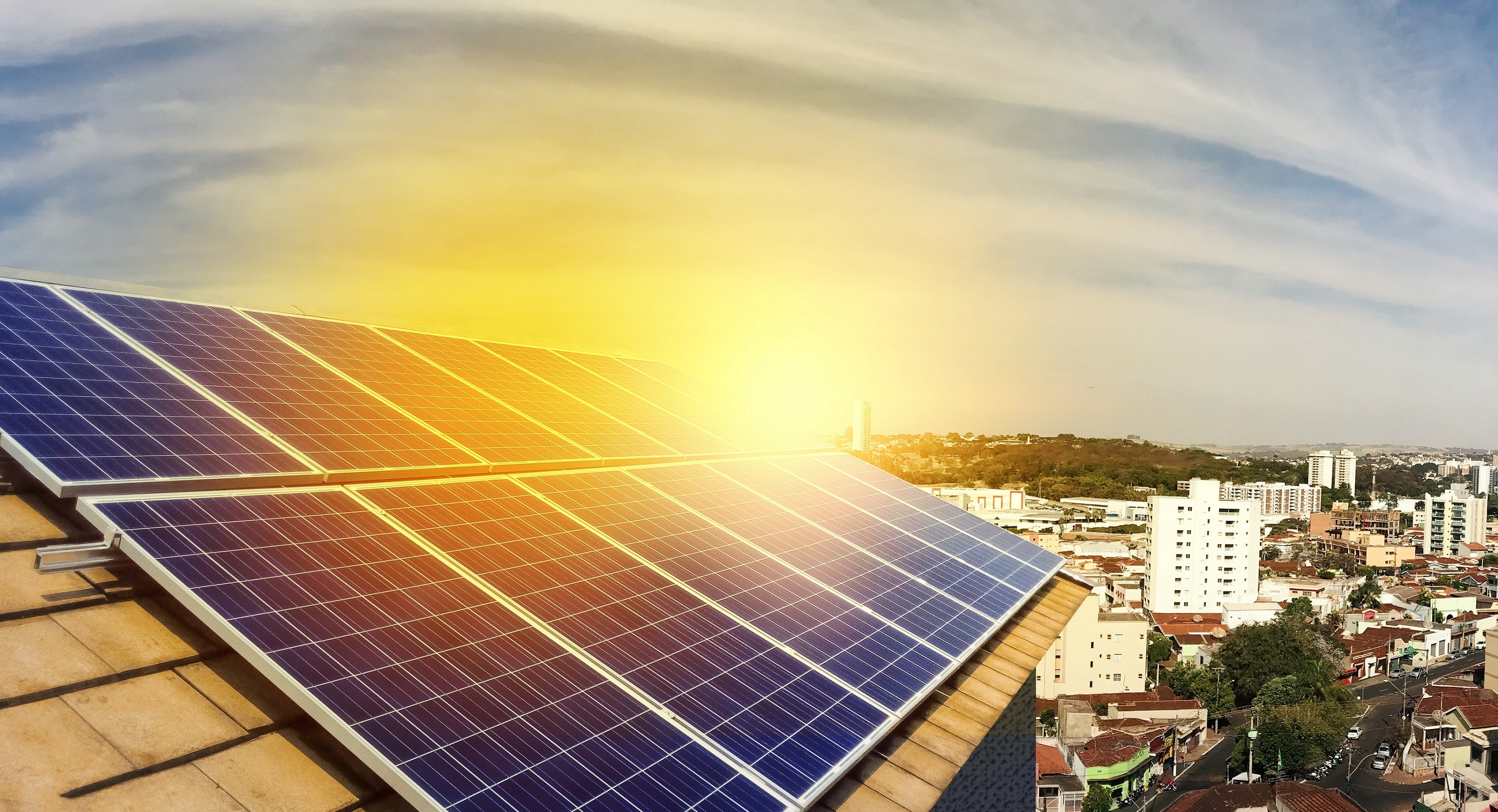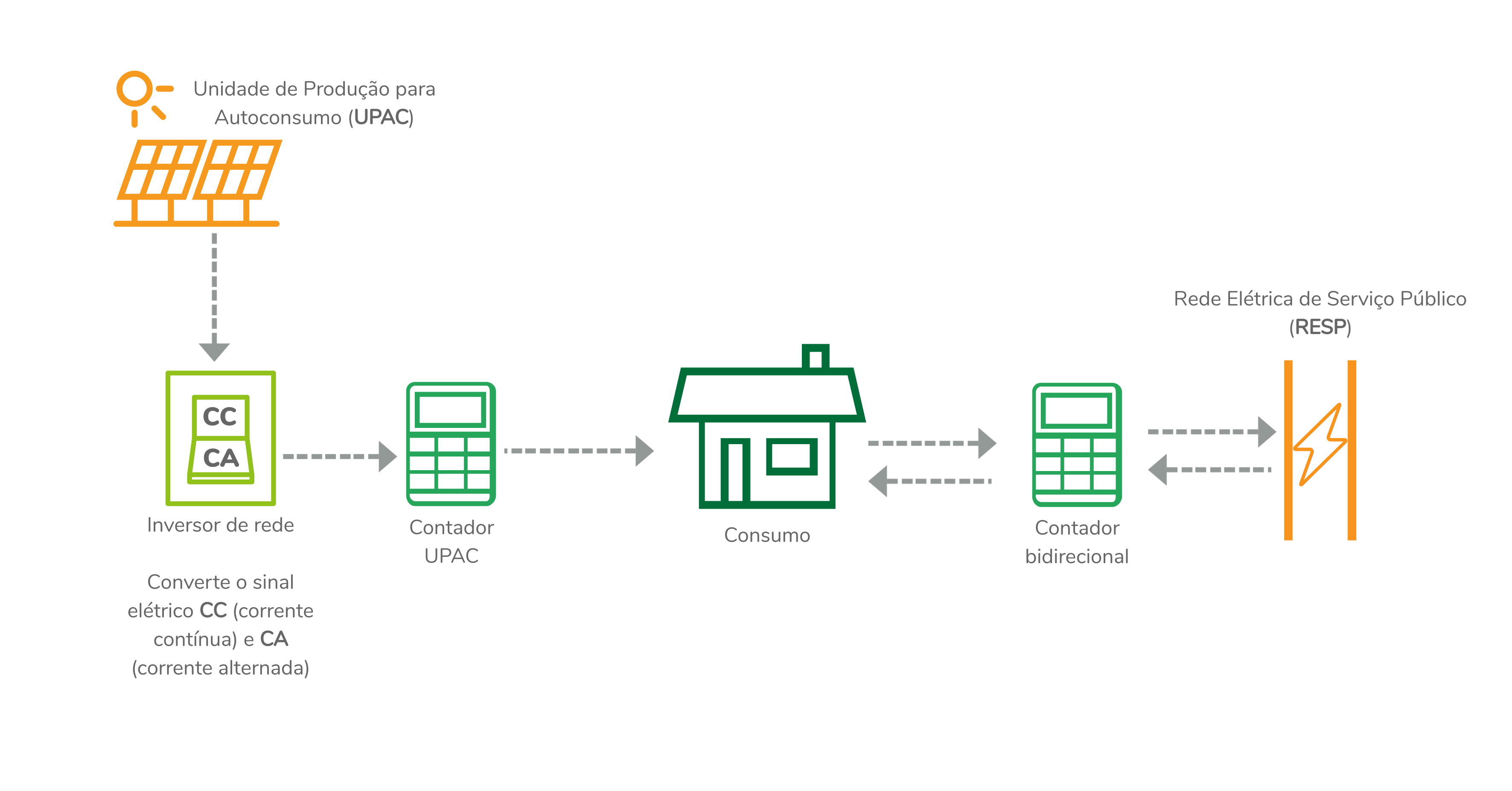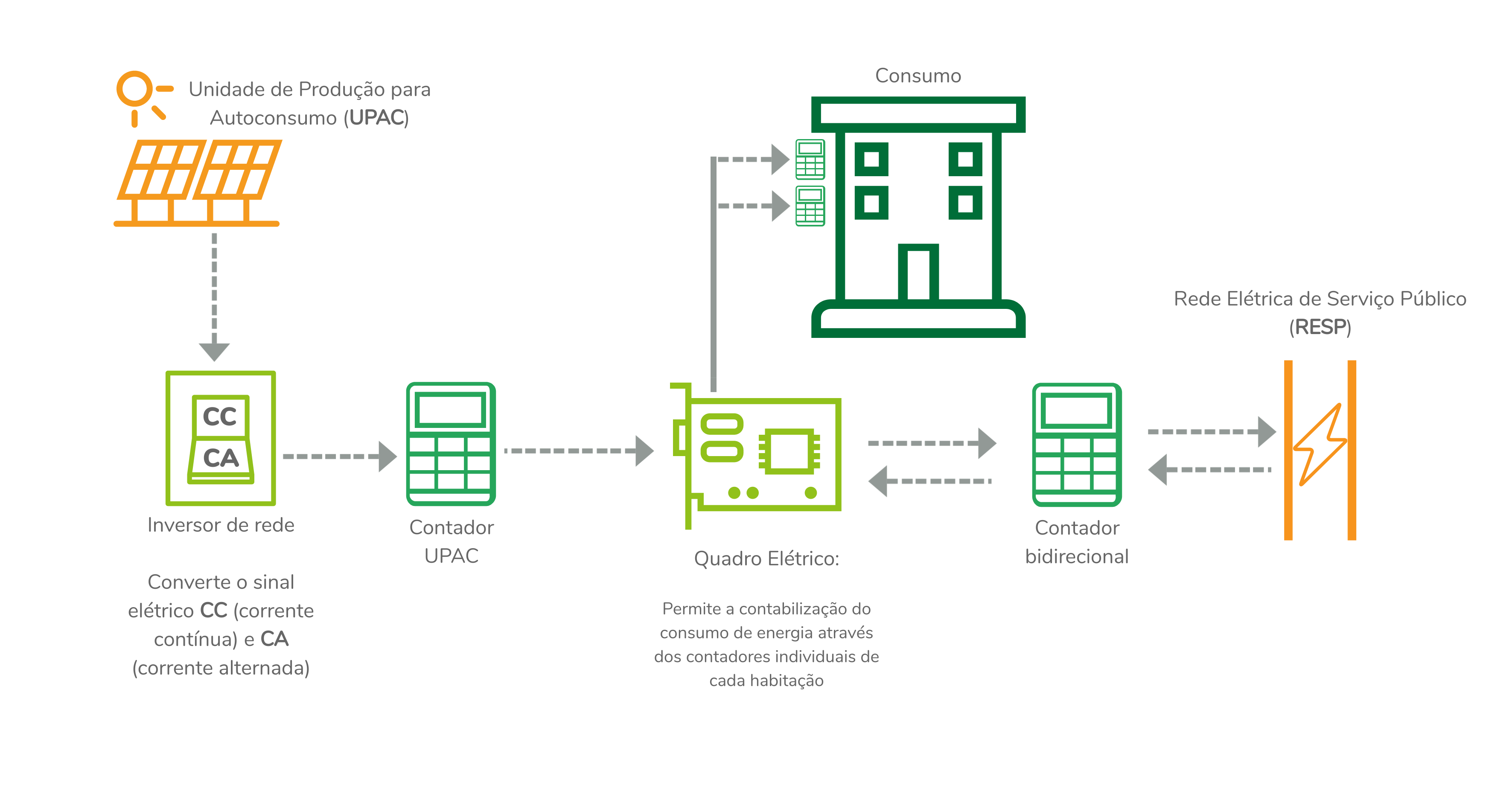
Your Energy
A smart alternative
SELF-CONSUMPTION IS THE PRODUCTION OF ELECTRIC ENERGY WITHIN UTILIZATION INSTALLATIONS (IU), WHETHER HOUSES, COMMERCIAL SPACES OR OTHER COMPANIES, FOR CONSUMPTION IN THE OWN INSTALLATION, THROUGH A PRODUCTION UNIT FOR SELF-CONSUMPTION (UPAC).
The new regime only provides for production using renewable energy sources. Self-consumption has the virtue of taking advantage of renewable resources and minimizing the use of resources in the electrical system (the transmission and distribution networks, the associated losses).
Advantages of self-consumption
Savings
Self-consumption can lead to a reduction in electricity bills of up to 80%, depending on the type of solution adopted or the location of the house / company, among other factors, which must be taken into account before any installation.
Efficiency
Installing a UPAC will make your home more efficient and can increase your energy class.
Sale of Energy Surplus
Performed by entering into a contract between the producer and the supplier of last resort (CUR) or a free market supplier, for a maximum period of 10 years, renewable for periods of 5 years, the price of energy being calculated according to the law.
What do you need to know before installing a UPAC?

Procedure
The production for self-consumption presupposes an administrative procedure with the Direção-Geral de Energia e Geologia prior to the beginning of the activity, whose requirements depend on the installed power of UPAC.

Legislation
Find legal information on self-consumption at Observatório da Energia, where you can consult DL No. 162/2019, of 25 October and Regulation No. 266/2020, of 20 March.

- Electricity producing equipment: photovoltaic panel, wind fan, among others;
- Mains inverter: Automatic or manual command and maneuvering system (converts electricity produced in the form of direct current to electricity consumed in the form of alternating current);
- UPAC counter: counts the total energy produced;
- Bidirectional meter: calculates the surplus energy produced by UPAC and consumed by the Public Service Electric Network (RESP);
- Batteries (optional)

- UPAC with an installed power of 350 W or less is not subject to prior control.
- UPAC with installed power greater than 350 W and less than or equal to 30 kW is subject to mere prior communication. No. 206 of October 25, 2019 Page 49 Diário da República, 1st series of August, in its current wording.
Note: for contracted powers above those identified, see DL. No. 162/2019.

- The installation of UPAC with an installed power greater than 350 W is mandatorily performed by a certified installer of electrical installations for private service or technicians responsible for the execution of electrical installations, under the terms of Lei n.º 14/2015, of February 16, and Decreto -Lei n.º 96/2017, of August 10, in its current wording.
- The installer entity or the responsible technician, as applicable, must ensure that the equipment to be installed is certified under the terms of Artigo 14º do DL n.º162/2019.
- The installer entity or responsible technician, as applicable, must ensure that UPAC is exempt from prior control or duly registered or licensed, under the terms of this decree-law, as applicable.
- The installer entity must declare on the Portal the installed UPAC, indicating the installed power, the technology used and the parish and county of location.

UPACs with installed power greater than 20.7 kW are subject to periodic inspections, which are carried out with the following periodicity:
a) 10 years, when the installed capacity of UPAC is less than 1 MW;
b) Eight years, in the remaining cases.
CAN THE REGISTRATION OR LICENSE BE CANCELED?
UPACs registration or license is canceled, as the case may be, whenever:
a) Due to circumstances attributable to the self-consumer, it is not the object of periodic inspection under the terms of paragraph 1, within the deadlines established there;
b) During the periodic inspections, nonconformities are identified and they are not corrected and the corresponding reinspection record is carried out, within a maximum period of 22 days.
HOW DO UPACS WORK AND WHAT’S RETURN ON INVESTMENT (ROI)?
Individual self-consumption is one that corresponds to the production of electric energy from
renewable sources, internally to the installation of use, for consumption in that same installation, having
the production unit and the installation of use the same holder.
A UPAC IMPLEMENTATION SCHEME FOR PRIVATE CONSUMPTION

APPLICATION EXAMPLE
What is the ROI of a UPAC with photovoltaic panels for housing in the district of Lisbon, with a consumption of 3000 kWh / year, a contracted power of 6.9 kVA and an energy price of around 0.14 € / kWh?
| UPAC | |
| Photovoltaic solar power | 2 kW |
| No. of photovoltaic panels | 6 |
| Area occupied by the photovoltaic solar | 12 m2 |
| Building energy consumption | 3000 kWh |
| Solar energy production | 2286 kWh |
| Surplus energy | 430 kWh |
| Surplus Energy (%) | 19 % |
| Self-consumption | 1856 kWh |
| Renewable energy consumption | 62% |
| Annual energy costs | 393 € |
| Annual revenue with photovoltaic | 263 € |
| Annual reduction in energy bill | 67% |
| Estimated investment * | 2148 € |
| Annual operating and maintenance costs ** | 43 € |
| Return of Investment | 8.2 anos |
https://ecoap.pnaee.pt/ferramentas/calculadora-solar-fotovoltaico/
* The estimated investment includes the costs of the solar modules, with inverter (s) and the respective installation costs.
** UPAC operation and maintenance costs are about 2% of the initial investment per year.
Collective self-consumption is a new modality that extends the concept of self-consumption to the possibility of producing electrical energy for various installations of use in the proximity (geographic and electrical) of the production unit. Underlying is the concept of energy sharing, between several consumers, who associate to make the investment in the production unit. In order to implement energy sharing, the network operator will allocate the energy produced by each associated consumer, according to factors defined by collective self-consumers through the respective «managing entity». As the production unit is not connected to a private network, where the installations of use are also connected, the energy sharing uses the public network, in which case it is subject to the payment of network access fees.
SCHEME FOR IMPLEMENTING A UPAC FOR COLLECTIVE CONSUMPTION

APPLICATION EXAMPLE
What is the ROI of a UPAC with photovoltaic panels for a condominium of 4 dwellings in the district of Porto, with a consumption of 3000 kWh / year per house (12000 kWh / year), a contracted power of 20.7 kVA and an energy price around 0.13 € / kWh?
| UPAC | |
| Photovoltaic solar power | 4 kW |
| No. of photovoltaic panels | 16 |
| Area occupied by the photovoltaic solar | 34 m2 |
| Comments | Potência da central otimizada pelo consumo e perfil de carga da instalação |
| Building energy consumption | 12000 kWh |
| Solar energy production | 6495 kWh |
| Energy surplus | 1246 kWh |
| Energy surplus (%) | 19 % |
| Self-consumption | 5249 kWh |
| Renewable energy consumption | 44% |
| Annual energy costs | 1572 € |
| Annual revenue with photovoltaic | 746 € |
| Annual reduction in energy bill | 47% |
| Estimated investment * | 6185 € |
| Annual operating and maintenance costs ** | 124 € |
| Return of Investment | 8.3 anos |
https://ecoap.pnaee.pt/ferramentas/calculadora-solar-fotovoltaico/
* The estimated investment includes the costs of the solar modules, with inverter (s) and the respective installation costs.
** UPAC operation and maintenance costs are about 2% of the initial investment per year.
You can consult the billing conditions in Regulamento nº 266/2020, of 20 March.



 Simulador Simples
Simulador Simples Simulador Avançado
Simulador Avançado